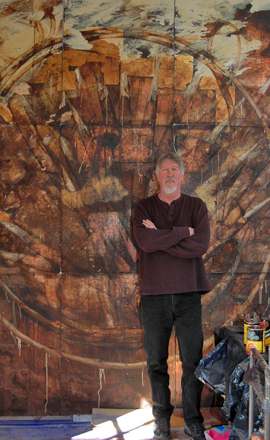
Springs artist David Geiser is reclaiming a bit of his past, traveling back to the psychedelic scene of some 40 years ago to summon some of his special skills in classes for kids and adults.
In 1969, fresh from graduating from the University of Vermont, Mr. Geiser found himself in San Francisco. Smack in the middle of a hotbed of political and social upheaval, the musicians, beat poets, writers and artists who were his neighbors were reacting to the seismic changes reverberating across the country.
A pendulum of choice swung for Mr. Geiser: accept an offer to study art on a Yale fellowship or continue his newfound involvement with the underground comic scene and the so-called underground comix: a subversive, no-holds-barred type of comic book in which sex, drugs and an unflinching look at the psychedelic scene dictated the plot line. Now collectors’ items, these subversive comics were among the forerunners of today’s graphic novels.
“I chose to stay in San Francisco,” Mr. Geiser said in an interview last week at his Springs home. “To this day I don’t know if it was the right decision, but I felt like I was in the middle of something that was happening right now and then. I feel like I would have missed something important if I went back northeast to study at Yale.”
Tapping into the characters that made up San Francisco’s scene, Mr. Geiser turned his artistic talent to comic illustrations. He met San Francisco Comic Book Company founder Grey Arlington and immersed himself in illustrations.
Underground comix provided searing commentary on the drug-soaked counter culture of the ’60s and ’70s. Generally self-published or published by alternative presses, the underground comix freed the artist to explore the era of sex, drugs and rock and roll as it unfolded, without the restrictions imposed by commercial producers.
The scene included R. (Robert) Crumb, creator of Mr. Natural and Fritz the Cat, among other characters. The father of the underground comix movement, R. Crumb was the founder/producer of Zap Comix. Rick Griffin was a psychedelic poster artist and illustrator for many of the Grateful Dead album covers; S. Clay Wilson was an extreme Zap Comix artist.
Structurally, the underground comix were similar to today’s graphic novels and comic books. There are panels of illustrated characters and dialog that tell a story. Illustrations are rendered in black and white. Highly detailed, they are stuffed with imagery and unusual characters who play the hero in their everyday dramas. The visuals appear to be hand-drawn. Characters have exaggerated features. Page composition can have a rough yet pleasing look. There’s plenty to see and one-liners abound.
Mr. Geiser published a series of underground comix, based on characters and situations he observed on the San Francisco scene. The number of issues produced ranged from 1,000 to about 10,000. The titles included “Uncle Sham,” “Demented Pervert,” “Honky Tonky,” “DTs” and “Sloppy Seconds.” His publication, “Pain,” was picked up by Bagginer Press in Paris and distributed in Paris and the U.S.
Mr. Geiser also produced limited edition publications and panels. The panel, “Poets Last Supper” (from “DTs”), has been reproduced in books and poet biographies. A limited edition was produced and signed in the artist’s blood. While working as an underground illustrator, he created rock concert posters for the Fillmore, album covers for emerging bands, and contributed to Screw magazine and opinion illustrations for The New York Times.
Sometime in the late ’70s, Mr. Geiser turned away from illustrations and reclaimed his painting past. Since then, he has been creating abstract paintings that feature layers of pigment, conjuring nature and implying a hidden history arising from the structural field of the artwork. His art has been exhibited in solo shows at the Butters Gallery in Portland, Oregon, the Kim Foster Gallery in Manhattan and in galleries in Buenos Aires, Argentina, Chicago, Illinois, California, Maryland and more.
In both his paintings and underground comix, Mr. Geiser searches to capture a rare truth and impart it in his art. Texture is another aspect binding the two forms together.
This week, Mr. Geiser will revisit his distant past, leading three workshops on how to make graphic novels—two at the Ross School and one at Guild Hall in East Hampton.
A seven-session series, “Underground Comix and the Graphic Novel,” will be offered on Saturdays from 1 to 2:30 p.m. beginning on March 7 for ages 10 and up at the Ross School. The school will also host a class for adults on Thursdays from 6:30 to 8 p.m., beginning on March 5. For information, call 907-5555 or visit www.ross.org.
Guild Hall will host a “Graphic Novel & Cartoon Workshop” for young adults age 14 and up, with classes scheduled on Mondays from 4:30 to 6 p.m. The four-session series begins on March 9. For registration, call 324-0806 or visit www.guildhall.org.
Mr. Geiser’s art and underground comix can be seen at www.geiser.net.